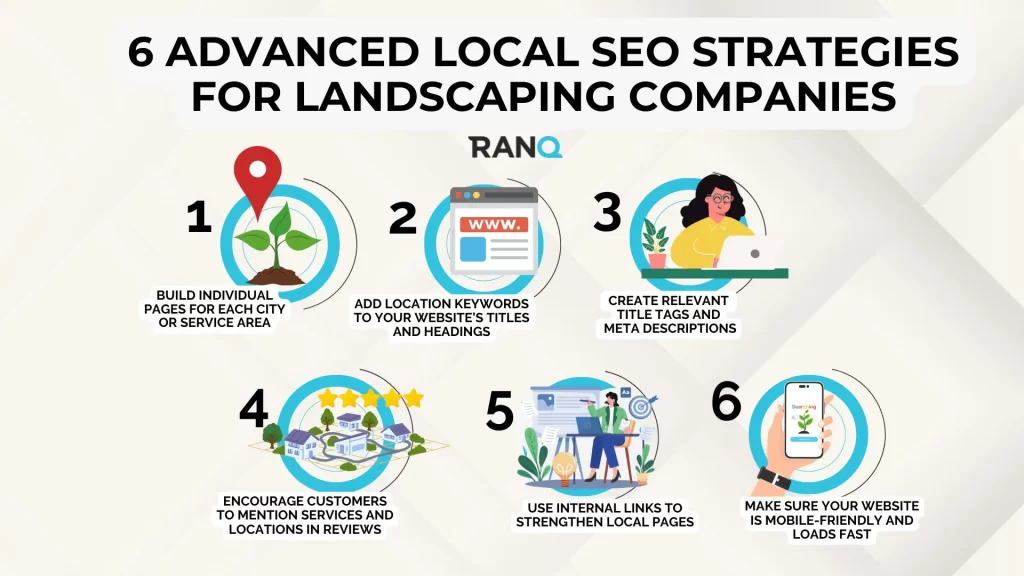As a landscaping company, you often rely on word-of-mouth and referrals for new customers, which can be unpredictable. If you want steady leads from people in your area, local SEO is the best method to attain them.
This guide will break local SEO into simple, beginner-friendly steps and illustrate how local SEO can help your landscaping company raise its online visibility and bring in new customers.
What is local SEO for landscaping companies?

Local SEO is the practice of improving your online visibility so that your website will rank higher on Google (and other search engines), and draw in more potential customers from your geographic area.
Landscaping is an inherently local service, and your most significant target market is going to be people who live or work in close proximity to your location.
That’s why optimizing your website for local search queries like “landscapers near me” or “landscapers in X city’ is critical.
Why word-of-mouth isn’t enough anymore
In the past, you’ve relied on referrals and “being known in the area” but that isn’t enough anymore. Statistics show that more than 75% of all prospective customers begin their search online, even in cases where the customers were referred.
You need to supplement your quality work with online visibility. Local SEO isn’t meant to replace referrals; it’s a tool that multiplies their impact.
1. Homeowners still Google you, even if they heard about you from a friend
Even if someone hears about your company from a friend, that potential customer will likely search your name online to check reviews, look at photos of past work, and verify that you’re a legitimate business.
If you have no web presence or a weak Google Business Profile, that prospect may move on to a competitor who is more visible in search engine results. This is especially true for younger homeowners, who expect to see a digital presence before reaching out for your services.
2. Referrals don’t scale, SEO does
It’s essential to have strong word-of-mouth, but it’s an unpredictable system. One week, you may receive three calls. And the next month, you could receive none. Local SEO creates a consistent, search-based stream of new leads from people actively looking for landscaping companies like yours.

3. People want to see proof before they call
More than in other industries, visual evidence of your handiwork is crucial in landscaping to convince the customer to use your service. Prospective customers will want to see your past work. And even with a referral, searchers will want to see before-and-after photos of properties, read reviews, and understand your working style and what to expect.
When that online content (A gallery of past work, customer reviews, and completed Google Business Profile) isn’t available, the customer has to rely on someone else’s memory and description of your company.
4. Your competitors are more visible even if you’re better
You can be the best landscaping company in a given area, but prospective customers won’t always choose the best landscaper. They’ll go with the most visible one. If your competitors are leveraging even basic SEO (Google Business Profile posts, location pages, customer reviews), they may be stealing business that should have been yours.

5. SEO strengthens referrals instead of replacing them
The goal of local SEO isn’t to replace referrals – it’s to make sure they convert into a paying client. When someone Googles you after hearing your name, they should see:
- A 4.9-star Google rating for your company
- A filled-out Google Business Profile
- Multiple high-quality, representative photos of your work
- An easy-to-navigate, clear website with a contact form
The core building blocks of local SEO for landscaping companies
In the next section, we’ll discuss the two core building blocks of local SEO for landscaping companies: the Google Business Profile and targeted location-based keywords.
Set up and optimize your Google Business profile
Here are the things you need to set up and optimize your company’s Google Business Profile:
- Include photos, offered services, hours, and service areas on your profile
- Post regularly! Regular posts that feature photos are part of what indicates your company’s relevance to Google. Seasonal reminders are also great as they demonstrate that you’re an active business that interacts with the profile.
- Encourage happy clients to leave reviews. Customer reviews are another way that you signal to Google your relevance as a provider of a given service. Keywords can also help (e.g. “retaining wall in Plano,” “hardscaping in Evanston”).
- Enable messaging: Being active also means responding to customers when they have positive and negative things to say about your company.
Use location-based keywords on your website
Local SEO also extends to your company’s website. Optimizations can include:
- “Landscaping in [City]” or other geography-specific descriptors should appear in page titles, headers, and body text
- Make a separate page for each major service or city you serve (e.g., “Lawn Care in Austin,” “Stone Pathway Installation in Round Rock”)
- Free tools like Google Keyword Planner or UberSuggest can help you find useful keywords.
Advanced local SEO strategies for landscaping companies

You can focus on the basic building blocks listed above, but the strategies below are the bread and butter of local SEO, and can help you get ahead of competitors in your area.
1. Build Individual Pages for Each City or Service Area
Many landscaping companies will serve multiple cities or towns, but Google won’t rank a generic “Service Area” page for each of those places. Here’s how you can have these pages rank.
What to do:
- Create separate pages, such as “Landscaping in Cedar Rapids” or “Lawn Care Services in Naperville,” for each service and service area.
- Do not copy information from each page to the next. They need to offer unique information
- Mention specific neighborhoods, zip codes, and even local landmarks on each page.
- Add photos from actual projects in those areas on their respective pages.
2. Add Location Keywords to Your Website’s Titles and Headings
When deciding how to rank your website, Google pays close attention to your page titles, URLs, and headings (H1s and H2s). Adding your service and city in these titles and headings helps you rank in local searches.
What to do:
- Update your homepage title from “Green Leaf Landscaping” to “Professional Landscaping Services in Tulsa”
- Include phrases like “landscape design in [city]” in your service page headings
- Make sure these additional keywords feel natural. If they feel unnatural, this is known as keyword stuffing, and it Google could ding you and rank you lower.
3. Create relevant title tags and meta descriptions
Title tags (or meta titles) and meta descriptions are the first things people see in search results, influencing both search engine results ranking and clicks. These HTML elements label the name of a web page and offer a short summary of the content. Here’s how to optimize these elements:
What to do:
- Make sure every page of your website has a unique title tag with your service + city (e.g. “Hardscaping Services in Spokane | Evergreen Landscaping”).
- Keep the title tag under 60 characters so it doesn’t get cut off.
- Write a short, compelling meta description that includes the location and benefit.
- Example: “Need expert lawn care in Madison? We offer reliable, seasonal services that keep your yard beautiful year-round.”
4. Use Internal Links to Strengthen Local Pages
Internal links are hyperlinks that point to other pages on your own website. They help Google understand your site’s structure and prioritize important content, including location and service pages. They can also help signal authority to search engines.
What to do:
- Link from your homepage and service overview to your city-specific pages
- Example: “See our full list of landscaping services in St. Louis”
- Make sure internal links use useful anchor text (not just “click here”). Anchor text is the visible, clickable text in a hyperlink.
5. Encourage Customers to Mention Services and Locations in Reviews
Google examines the language in your customer reviews. If customers mention specific services (“retaining wall”) and cities (“in Aurora), it can help you rank for those terms.
What to do:
- After a successful job, send a quick message to the customer like: “If you’re happy with your backyard makeover in Southlake, would you mind leaving a review and mentioning what service we provided?” Never write fake reviews, but guiding customers to write about something specific is fine.
6. Make Sure Your Website Is Mobile-Friendly and Loads Fast
Nearly 57% of local searches for businesses happen on phones. If your site is slow or hard to navigate, your potential customer could move on to another competitor.
What to do:
- Use Google’s PageSpeed Insights to check load times. The average web page time to load on mobile is 8.6 seconds.
- Compress large images.
- Test your website on your own phone. Is it easy to find your contact information and call your business? Can you fill out a form online?
Local SEO for landscaping companies can get overwhelming – RANQ can help!
Between Google Business Profile updates, building service pages, requesting reviews, and optimizing your site, local SEO services can be overwhelming. Most landscaping companies don’t have a dedicated marketing team, and that’s okay.
Local SEO is one of the highest ROI marketing strategies for landscaping companies, and even doing a few things consistently (like updating your GBP and collecting reviews) can help raise your visibility.
But if you want to go beyond the basics of local SEO or don’t have time to keep up, it’s worth partnering with the experts at RANQ. Through robust keyword research, targeted monthly blog content, and regular improvements to site speed, RANQ can help bring new visibility to your landscaping company and attract new customers.


